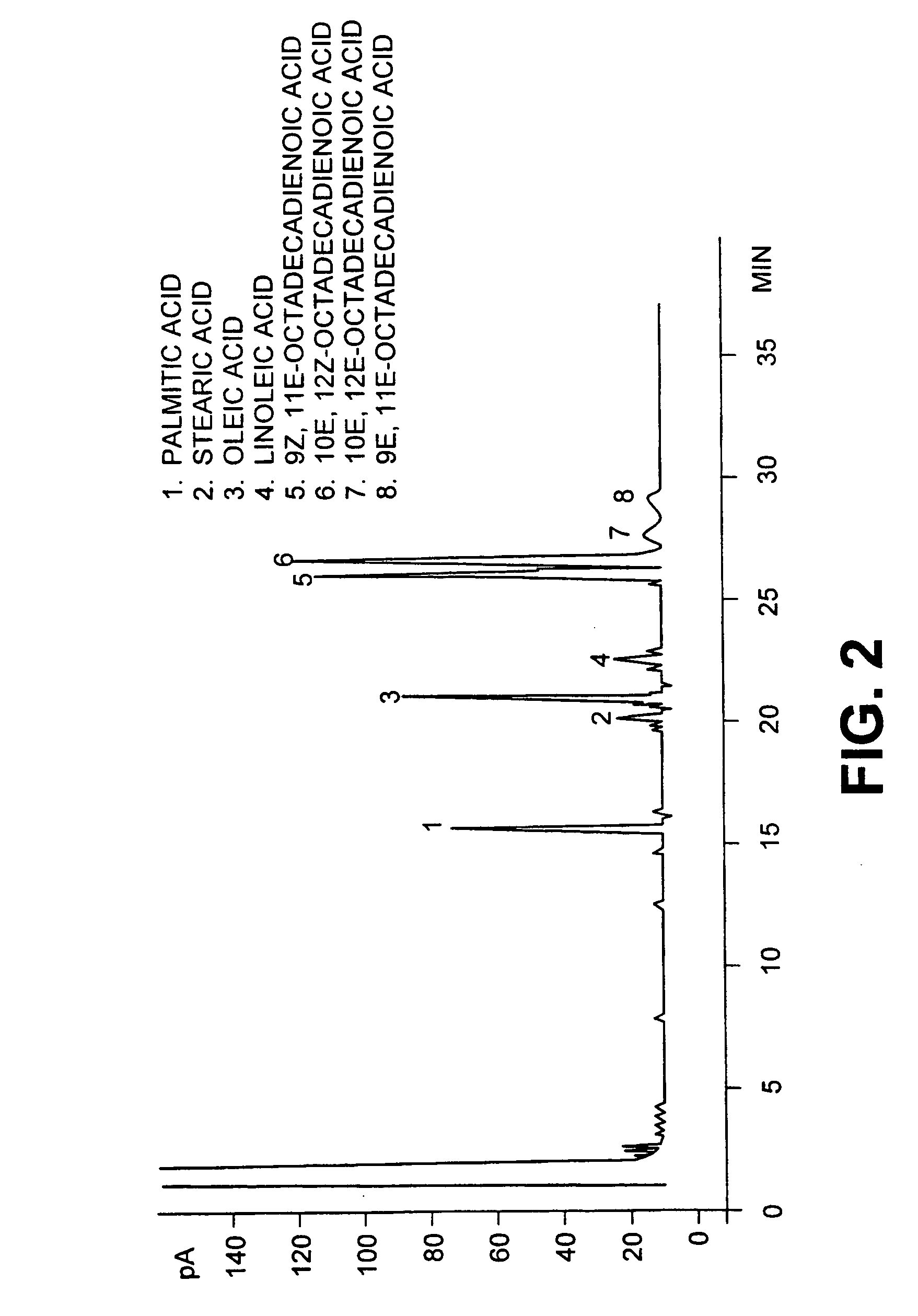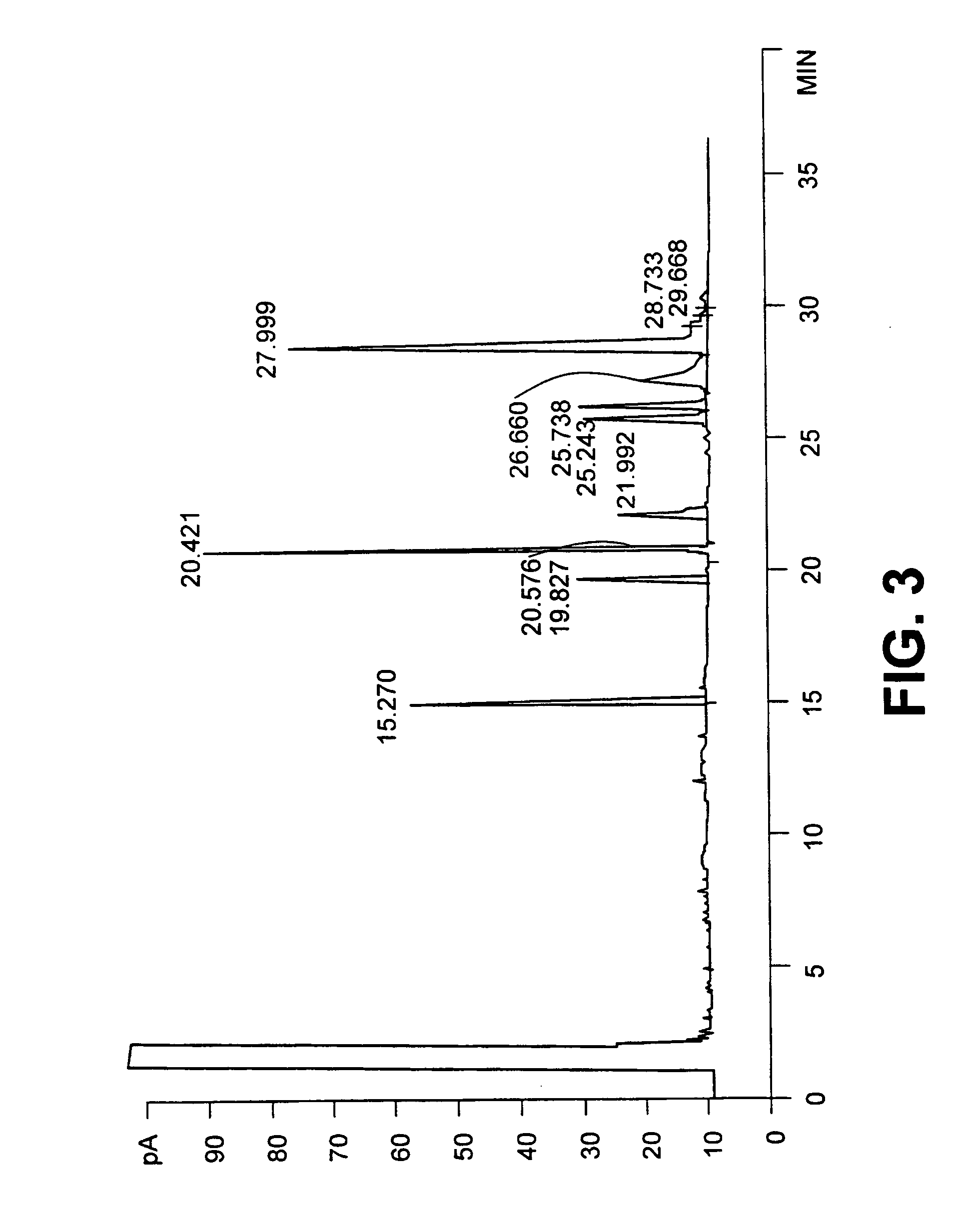Method for commercial preparation of preffered isomeric forms of ester free conjugated fatty acids with solvents systems containing polyether alcohol solvents
a technology solvent systems, which is applied in the direction of fatty acid isomerisation, fatty acid production, organic isomerisation, etc., can solve the problems of ineffective reaction, undesirable presence of ester free conjugated fatty acids in the cla product, and expensive elimination reagents
- Summary
- Abstract
- Description
- Claims
- Application Information
AI Technical Summary
Benefits of technology
Problems solved by technology
Method used
Image
Examples
example 1
[0027] Sequential Hydrolysis and Isomerization of One Part Safflower Oil to CLA in One Part PEG 300.
[0028] To 600 g of PEG 300 were added commercial safflower oil (590 g) and aqueous KOH (45% w / w, 299 mL). The resulting reaction mixture was heated at 140.degree. C. for 2 hours in a two litre beaker with vigorous agitation. During heating vigorous boiling occurred, as water was lost from the system. After cooling to 100.degree. C., the reaction mixture was acidified with H.sub.3PO.sub.4 (85%, 222 ml).
[0029] The resulting mixture was heated for 0.5 h at 95.degree. C. After standing for 0.5 hours at 95.degree. C., the top CLA layer was removed, washed with H.sub.3PO.sub.4 (60%, 222 mL) at 95.degree. C. for 30 minutes to remove excess PEG and water. The dried CLA layer was removed. The CLA product contained less than 0.1% water and less than 0.0125% PEG as determined by the method of Muir et al. (Muir, A., A. Aubin and M. J. T. Reaney 1998, "Determination of polyethylene glycol (PEG 300...
example 2
[0030] Sequential Hydrolysis and Isomerization of Two Parts Safflower Oil to CLA in One Part of PEG 300.
[0031] All conditions were similar to example 1 except that 300 g of PEG 300 were added commercial safflower oil (590 g) and aqueous KOH (45% w / w, 299 mL). The conversion of linoleic acid to CLA was confirmed by gas chromatography as described above. Under these reaction conditions most of the linoleic acid had reacted to form conjugated linoleic acids. Of the 74.2% linoleic acid in the starting material a total of 13.0% remained unreacted in the final product. Complete conversion of linoleic acid was achieved by longer reaction times not shown here
example 3
[0032] Sequential Hydrolysis and Isomerization of Safflower Oil to CLA in PEG 200.
[0033] All conditions were similar to example 1 except that PEG 200 (molecular weight 200 g / mole) was substituted for PEG 300. The conversion of linoleic acid to CLA was confirmed by gas chromatography as described above. Under these reaction conditions most of the linoleic acid had reacted to form conjugated linoleic acids. Of the 74.2% linoleic acid in the starting material a total of 2.3% remained unreacted in the final product. Conversion of linoleic acid of linoleic acid to CLA could be considered to be complete for commercial purposes.
PUM
| Property | Measurement | Unit |
|---|---|---|
| temperature | aaaaa | aaaaa |
| pH | aaaaa | aaaaa |
| temperature | aaaaa | aaaaa |
Abstract
Description
Claims
Application Information
 Login to View More
Login to View More - R&D
- Intellectual Property
- Life Sciences
- Materials
- Tech Scout
- Unparalleled Data Quality
- Higher Quality Content
- 60% Fewer Hallucinations
Browse by: Latest US Patents, China's latest patents, Technical Efficacy Thesaurus, Application Domain, Technology Topic, Popular Technical Reports.
© 2025 PatSnap. All rights reserved.Legal|Privacy policy|Modern Slavery Act Transparency Statement|Sitemap|About US| Contact US: help@patsnap.com



